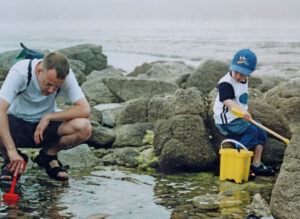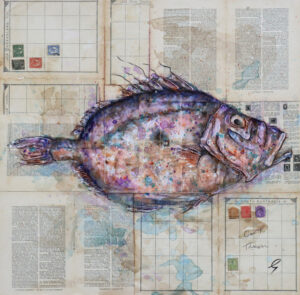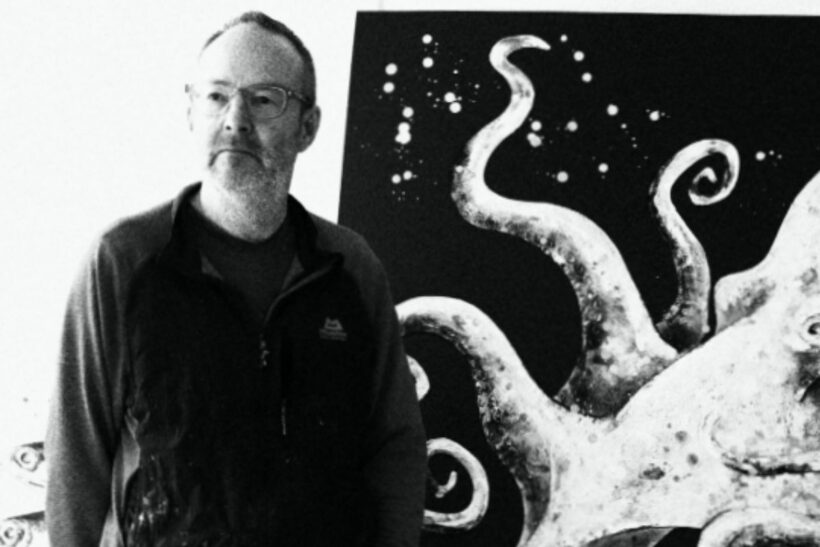Share a day in the life of an artist who specialises in painting fish and shellfish
The natural marine environment has become my specialism – that’s what people know me for,” Monmouthshire-based artist Giles Ward told Fishing News. “I think the root of that comes from childhood.
“I grew up in Sheffield, and as children we would come down to North Devon, to the seaside – like many families. I just loved looking in rock pools and messing about on the beach and picking up shells and putting crabs in buckets – I had an absolute fascination.”

Giles in 2003 with his six-year-old son Sam. Giles’ interest in the natural world started as a young child when holidaying on the North Devon coast. “I think I was both fascinated and horrified by fish and crustaceans and sea creatures. I’m sure that’s where my visual fascination for these creatures came from.”
After completing a fine art course in Sheffield, Giles moved to Exeter aged 18 to study illustration. However, after graduating, his creative talents were initially put to other uses.
“To build a career, so I could earn enough to have a family and a home, I moved into graphic design and advertising, and later set up my own advertising agency. That was my commercial career for 30 years – marketing, advertising and designing.”
Six years ago, Giles decided it was time for a life change. “The artistic element never left me. In the background I would always be drawing, sculpting, creating collages – as a hobby.
“When it reached the point where I thought I could spend more time dedicated to art, I thought: why not give it a go and see if I can make it work?”
All Giles needed was a subject. “That’s when I thought: fish. Take any fish – a sardine, for example. You start looking at it and there’s so much world in there – it’s the colours, the shapes, the shine – there’s no two colours at once.”
A typical day for Giles begins in his home-based studio – but not at the easel. “A lot of friends ask if, now I’m a full-time painter, I just paint all day – but there’s a lot of other elements to it. I’ve a network of galleries which I now support and send my work to. So there’s quite a lot of talking to galleries and people I’m working on commissions for.
“I also sell direct from my website. So if there’s any organising of that to be done, I’ll do that as well.”
With the administrative tasks complete, Giles moves on to the more creative side of his role.
“I find my most productive time to start painting is early to mid-morning. I don’t paint one picture, and then stop, and then paint another. It’s not a production line – I am producing a number of works in one go.

The John Dory is one of Giles’ most popular subjects. “I started off painting sardines and mackerel – fish people are drawn to. And then I thought a fish like John Dory is a fascinating creature. They are ugly – but also beautiful. I thought nobody would like a painting of one because it’s such a funny-looking fish – but they’ve proved to be one of the most popular.”
“They will be in different stages of development. My work is very heavily textured – and that’s a very important part of what I do. It’s thick paint, but I also put on lots of other things. If I’m painting a crab, I will actually put in crab shell. I’ll put in sawdust, housepaint – I’ll use spray paints. All those things take a lot of time to dry, so quite a bit of my day is seeing where I am with different pictures and building them up.”
When it comes to a new painting, a trip to the fishmonger’s is on the cards.
“When I’m starting a picture – let’s say I’ve been inspired by anchovies – I like to work from life – but of course an anchovy will go off very quickly, so I’ll need to go and source the anchovies and then photograph them.
“I’ll work out what photos I like, and from which sort of angles and presentation. Then I prepare the canvas by priming it, and then I’ll sketch onto the canvas. From that point on, I’m building up the layers of acrylic paint underneath, then lots of different textures and different kinds of paint, and then finishing it off with oil paint.”
Giles’ working day also sees him tap into some of his previous career experience, with marketing a key element – and as well as advising other artists on how to market themselves, he also needs to promote his own work.
“I look after the social media side of things. I now do for myself, what I’ve spent many years advising clients to do.
“My website is very thorough and kept up to date. My wife and I manage that, and work it so we can update it if I have a new print I want to add, or a news story I want to talk about.
“It’s about using both the offline and the online world. The offline world is getting my physical pictures in front of as many people as possible, through galleries or exhibitions. Then it’s trying to get anybody who sees my work to visit my website, and if they like what I do, to join my mailing list.
“I can then let people know what I’m doing next, where they can see my work and what new paintings I’m working on. I thoroughly analyse the analytics from the emails and website to see what people are interested in.”
Giles’ final task of the day ensures the following morning begins in productive fashion.
“I’ve disciplined myself to lock the door to my studio, and that has made me a better artist. The next morning, I come to it refreshed.”
More information is available at: giles-ward.com
This feature was taken from the latest issue of Fishing News. For more up-to-date and in-depth reports on the UK and Irish commercial fishing sector, subscribe to Fishing News here or buy the latest single issue for just £3.50 here.
Sign up to Fishing News’ FREE e-newsletter here.






